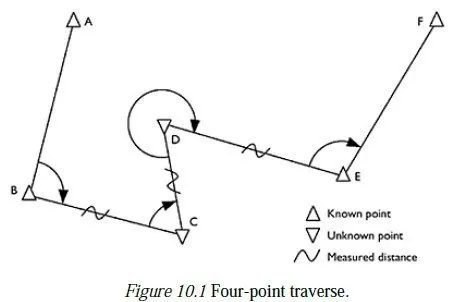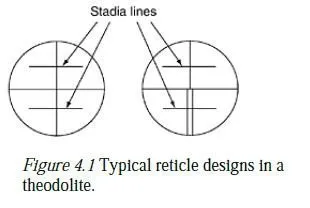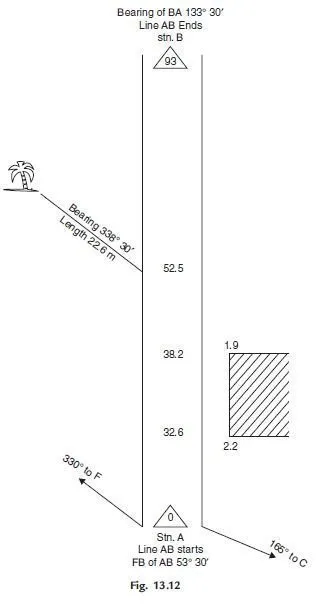Contouring needs the determination of elevation of various points on the ground and at the same the horizontal positions of those points should be fixed. To exercise vertical control levelling work is carried out and simultaneously to exercise horizontal control chain survey or compass survey or plane table survey is to be carried out. If the theodolite is used both horizontal and vertical controls can be achieved from the same instrument. Based on the instruments used one can classify the contouring in different groups.
However, broadly speaking there are two methods of surveying:
1. Direct methods
2. Indirect methods.
Direct Methods
It consists in finding vertical and horizontal controls of the points which lie on the selected contour line.
For vertical control levelling instrument is commonly used. A level is set on a commanding position in the area after taking fly levels from the nearby bench mark. The plane of collimation/height of instrument is found and the required staff reading for a contour line is calculated. The instrument man asks staff man to move up and down in the area till the required staff reading is found. A surveyor establishes the horizontal control of that point using his instruments. After that instrument man directs the staff man to another point where the same staff reading can be found. It is followed by establishing horizontal control. Thus several points are established on a contour line on one or two contour lines and suitably noted down. Plane table survey is ideally suited for this work. After required points are established from the instrument setting, the instrument is shifted to another point to cover more area. The level and survey instrument need not be shifted at the same time. It is better if both are nearby so as to communicate easily. For getting speed in levelling some times hand level and Abney levels are also used. This method is slow, tedious but accurate. It is suitable for small areas.
Indirect Methods
In this method, levels are taken at some selected points and their levels are reduced. Thus in this method horizontal control is established first and then the levels of those points found. After locating the points on the plan, reduced levels are marked and contour lines are interpolated between the selected points.
For selecting points anyone of the following methods may be used:
(a) Method of squares,
(b) Method of cross-section, or
(c) Radial line method.
Method of Squares: In this method area is divided into a number of squares and all grid points are marked (Ref. Fig. 17.6). Commonly used size of square varies from 5 m × 5 m to

20 m × 20 m. Levels of all grid points are established by levelling. Then grid square is plotted on the drawing sheet. Reduced levels of grid points marked and contour lines are drawn by interpolion [Ref. Fig. 17.6].

Method of Cross-section: In this method cross-sectional points are taken at regular interval. By levelling the reduced level of all those points are established. The points are marked on the drawing sheets, their reduced levels (RL) are marked and contour lines interpolated.
Figure 17.7 shows a typical planning of this work. The spacing of cross-section depends upon the nature of the ground, scale of the map and the contour interval required. It varies from 20 m to 100 m. Closer intervals are required if ground level varies abruptly. The crosssectional line need not be always be at right angles to the main line. This method is ideally suited for road and railway projects.
Radial Line Method: [Fig. 17.8]. In this method several radial lines are taken from a point in the area. The of each line is noted. On these lines at selected distances points are marked and levels determined. This method is ideally suited for hilly areas. In this survey theodolite with tacheometry facility is commonly used.

For interpolating contour points between the two points any one of the following method may be used:
(a) Estimation (b) Arithmetic calculation
(c) Mechanical or graphical method.
Mechanical or graphical method of interpolation consist in linearly interpolating contour points using tracing sheet:
On a tracing sheet several parallel lines are drawn at regular interval. Every 10th or 5th line is made darker for easy counting. If RL of A is 97.4 and that of B is 99.2 m. Assume the bottom most dark line represents. 97 m RL and every parallel line is at 0.2 m intervals. Then hold the second parallel line on A. Rotate the tracing sheet so that 100.2 the parallel line passes through point B. Then the intersection of dark lines on AB represent the points on 98 m and 99 m contours [Ref. Fig. 17.9]. Similarly the contour points along any line connecting two neighbouring points may be obtained and the points pricked. This method maintains the accuracy of arithmetic calculations at the same time it is fast.

Drawing Contours
After locating contour points smooth contour lines are drawn connecting corresponding points on a contour line. French curves may be used for drawing smooth lines. A surveyor should not lose the sight of the characteristic feature on the ground. Every fifth contour line is made thicker for easy readibility.
On every contour line its elevation is written. If the map size is large, it is written at the ends also.




This is important!
in this link contouring is defined verywell it should be read sincerely